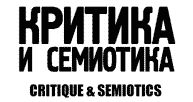JERUSALEM’S ANATOPY
The article discusses the ways of visual transfer of Jerusalem and the Holy Land cultural realities on the Russian Christian culture. The specificity of this culture maximally expressed in the temple action. The relationship of the liturgical time with a real topography of the Holy Land as the place of the events described in the Gospel is investigated in this article. It demonstrates the meaning of the liturgical action as a pilgrimage to the holy places of Jerusalem and the surrounding area. The meaning is expressed in the semantic connection of historical events, its Palestinian localization and the liturgical “reproduction”. A temple area’s Palestinian “marking”, which is complemented by the iconic (sacral-visual) line is noted. When the liturgical tradition based on the Palestinian topic is transfered, reverse movement arises, i.e. the liturgically fixed topical markers are spread on space surrounding a temple. In consideration of the typological affinity name and image, the author draws attention to the iconic images as anagrams. He offers to define visual spatial complexes presented in such images-anagrams as “anatopy”. This images involve all semiotic features of anagrams, which indirectly marks a historical reality and its eschatological sense.
Keywords: temple space, iconic image, anatopy
References:
Ivanov 1977 – Ivanov V. Vs. On F. de Saussure’s anagrams. Ferdinand de Saussure. Works on linguistics. Moscow, 1977. P. 635–638. In Russian.
Pomyalovsky 1886 – Pomyalovsky I. V. Pilgrimage to the holy places of the end of IV century. Orthodox Palestinian collection. Is. 20. Saint-Petersburg, 1886. In Russian.
Toporov 1987 – Toporov V. N. To study anagrammatic structures (analysis). Studies on the structure of the text. Moscow, 1987. P. 193–238. In Russian.
Uspensky 1982 – Uspensky N. D. The Byzantine liturgy. Theological Works. Is. 23. Moscow, 1982. In Russian.
Issue: 2, 2015
Series of issue: Issue 4
Rubric: ARCHIVE
Pages: 126 — 131
Downloads: 943










